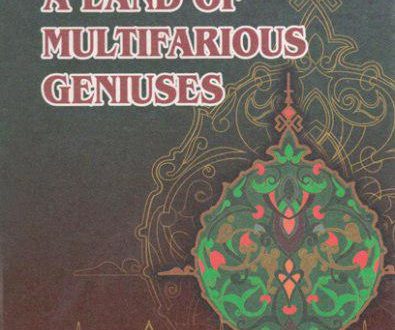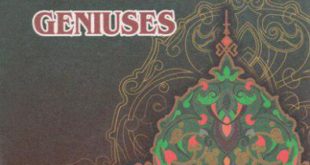The full name of the scholar known as Sheikh ul-Islam al-Hakim as-Samarqandi was Abu-l-Qasim Is’haq ibn Muhammad ibn Ismail ibn Ibrahim ibn Zayd al-Hakim as-Samarqandi. He was a famous expert in the sciences of Hadiths, law and kalam. He was also known as a vaiz in the Islamic world. In the historical sources written in the Arabic language, no information is given about his date of birth but his date of death. In some additional sources, his date of death is said to be 953. He was buried in the famous Chakardiza graveyard in Samarkand.
Al-Hakim as-Samarqandi was born in Samarkand, the centre of science and education, in its very period of high development. From his early ages, he was devoted to the science and knowledge. He was engaged in this field, received lessons from famous scholars and highly experienced specialists in different fields of the Islamic science. His estimated teachers and masters in his endeavours were the most famous scholars of his time as Abu-l-Hasan Ali ar-Rustughfani, Muhammad ibn Fazl al-Balkhi, Abu Mansur al-Maturidi, Abu Bakr al-Varraq, Muhammad ibn Khuzaym al-Qallas, Abu Nasr al-Iyadi, Abdullah ibn Sahl ar-Razi, etc. He received lessons from these experts on tafsir, hadith, especially law and kalam. He studied these sciences deeply and with great interest, and reached the highest level of estimation and appreciation.
A German expert in the Islamic sciences Ulrich Rudolf provided much information about Al-Hakim as-Samarqandi in his book “Al-Maturidi and religious Sunnah climate of Samarkand”. As is written in his above-mentioned book, the ruler of that time in Samarkand (892-907) Ismail ibn Ahmad summoned the experienced scholar; of Samarkand, Bukhara and other cities of Maveraunnahr and called them to compile a perfect manual discussing the Islamic problems and showing the right way of using these rules in real life. The main purpose from this call was to give a right definition of the Islamic rules and liquidate the supporters of different separations and parties in religion which had already spread to the vast territory of the Islamic world.
In practice, it would mean having a solid and strictly guaranteed complex of attitudes of Muslims to religion supported by both the scholars of the Islamic science and the ruler of the government. Accordingly, such a respectable and responsible task needed to be charged on a worthy specialist with profound knowledge in the Islamic sciences and respected as well as acknowledged scholar of that time. Such an estimated and appreciated expert was Al-Hakim as-Samarqandi. He had worked as a Head Qazi (Judge) of Samarkand for a long time. The task charged on Al-Hakim as-Samarqandi in its essence was closely connected with religious inatters rather than legal and sufistic ones. The complex to be compiled by Al-Hakim as-Samarqandi was to involve all the rules and demands of Islam and had to be perfect and clearly explained in a good and easy as well as understandable language for common people. The efforts of the author made in this direction at last i’ ailted in the creation of a book titled as “Kitab as-savad al-am” which later became one of the most famous manuals for Muslims in their spiritual life. Its full title sounded as “Radd a’la hab al-ahva al-musamma kitab as-savad al-a’zam a’la mazhab al-Imam Abu Hanifa”.
The work written by the scholar see ms to have met all then quirements of the time and demands of the spiritual world. Because in a short period of time it was acknowledged and appreciated a precious and original manual for Muslims in their everyday lives. It was immediately translated into Persian and began to be used as a textbook and manual in the Islamic educational systems. The first Arabic version of this manual was published during the mnii of Ottoman Turks. Moreover, there are other editions such as Cairo version (1837), Istanbul versions (1870, 1886, and 1894), etc. Oyini Afandi Bulghari published its modem Turkish version in 1842 in the city of Bulak, Turkey. The work was also translated into Tartar language and published in Kazan in 1881 and 1887. “As-savad al-a’zam” was also translated into Persian by A. Habibi and published in Tehran. Thirty years ago, it was investigated and defended in Edinburgh as a doctoral thesis by F.O.A. Umar and translated into English.
As has been mentioned above, at the time of al-Hakim as-Samarqandi, there appeared a number of separated parties and groups of Muslims in the religion who were deceived by aggressively spirited leaders. They described the essence of Islam from the mistaken points of view and led the common people to the wrong way of attitude to the Holy Qur’an and its essence. They went astray on the way of studying and defining the reality about the religion of Islam. Following the way of Imam Abu Mansur al-Maturidi, who fought against such separations and misleading in Islam, al-Hakim as-Samarqandi began an ideal fight for the purity of Islam against the mistaken and misled parties and groups in Islam and gave a sharp strike to the ideological centres.
 Imom Buxoriy xalqaro ilmiy-tadqiqot markazi bukhari.uz
Imom Buxoriy xalqaro ilmiy-tadqiqot markazi bukhari.uz











